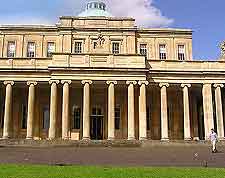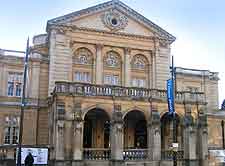Cheltenham History Facts and Timeline
(Cheltenham, Gloucestershire, England)

Cheltenham began as an Anglo-Saxon settlement. It's also believed to be the site of a 9th-century monastery.
Remarkably little is known of Cheltenham before it became a popular spa town. We do know, however, that it was granted a market charter in 1226, thus allowing the town to grow.
A Regency Spa Town
It's not until the 18th century that Cheltenham saw any real changes, including a dramatic rise to fame and fortune. The story goes that in 1716, a few townsfolk noticed that a particular flock of pigeons that pecked near a local spring were thriving. It wasn't long before they decided to taste the benefits of the mineral spring for themselves. Eventually, the owner of the land on which the spring stood took the entrepreneurial measure of installing a pump and charging people to 'take the waters'.
By 1850, history shows that Cheltenham had become the largest town in the county of Gloucestershire. Among the early visitors to Cheltenham were Samuel Johnson, the Duke of Wellington and the novelist Jane Austen. However, one visitor in particular served to boost the town's popularity. King George III visited in 1788, lodging at Bayshill. He could often be seen strolling around town, accompanied by his family.
Visitors to Cheltenham could opt to take the waters at the original spa, situated on the site of the present-day Cheltenham Ladies' College. Alternatively, they could enjoy one of the rival spas that emerged to meet growing demand - Montpellier and Pittville. The Pittville Pump Room, the work of Joseph Pitt, was built in 1830 and the spa waters can still be enjoyed here today.

The Victorian Era
During the course of the 19th century, fashionable shopping areas also grew up in the town, including the Promenade. The Assembly Rooms and the Theatre Royal were built to entertain the town's fashionable society.
By the 1840s, Cheltenham had become not just a popular place to visit, but also in which to live. By 1840, the town boasted some rather fine Regency houses. Of note, the town's Ladies' College opened in 1854.
Cheltenham's Racing History
It was during the early years of the 19th century that Cheltenham also acquired its links with horseracing. The town's earliest organised flat race meeting was held in 1815 on Nottingham Hill. Three years later, the first races were held on Cleeve Hill. However, not everyone was happy. In 1829, a local priest preached against the evils of horseracing and the grandstand was later burned to the ground. Consequently, in 1831, the racecourse was moved to Prestbury.
Modern-Day Times
Cheltenham inevitably declined as a spa town, although it remained a busy tourist destination and also served as a centre for business and the development of craft industries. In 1935, the steam-driven Cheltenham Spa Express - better known as the Cheltenham Flyer, achieved a record-breaking speed of 92.3 mph / 148.5 kph and this train regularly sped its way to Paddington Station in
London.
The post-war town is known for its association with Britain's spies. A secret surveillance centre was established here and named the GCHQ. The town is also the home of the prestigious Gold Cup steeplechase, part of the Cheltenham Festival that started in 1905. The racecourse has been considerably extended to allow it to cope with the growing popularity of 'a day at the races'. Redevelopment began in the 1960s and continues to this day.
 Cheltenham began as an Anglo-Saxon settlement. It's also believed to be the site of a 9th-century monastery.
Cheltenham began as an Anglo-Saxon settlement. It's also believed to be the site of a 9th-century monastery.